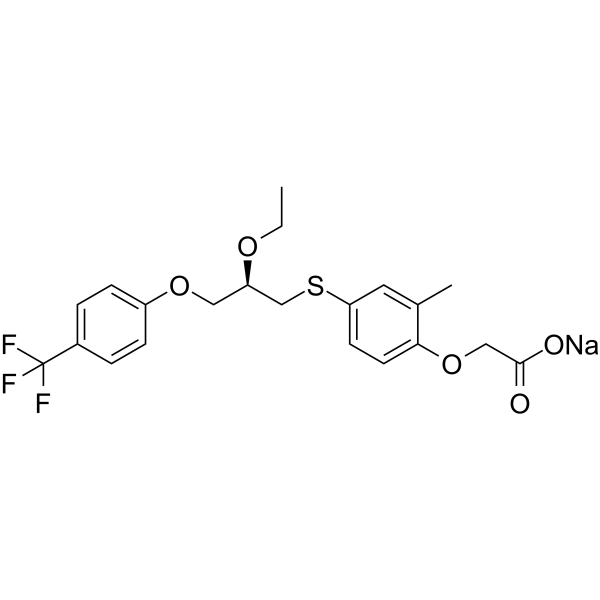| Cas No.: | |
| Chemical Name: | Seladelpar sodium salt |
| SMILES: | O=C(O[Na])COC1=CC=C(SC[C@H](OCC)COC2=CC=C(C(F)(F)F)C=C2)C=C1C |
| Formula: | C21H22F3NaO5S |
| M.Wt: | 466.45 |
| Purity: | >98% |
| Sotrage: | 2 years -20°C Powder, 2 weeks 4°C in DMSO, 6 months -80°C in DMSO |
| Description: | Seladelpar sodium salt (MBX-8025) is an orally active, potent and specific PPARδ agonist with an EC50 of 2 nM, showing more than 750-fold and 2500-fold selectivity over the PPARα and PPARγ receptors, respectively. |
| Target: | PPAR-δ 2 nM (EC50) |
| In Vivo: | In atherogenic diet-fed Wt mice, administration of Seladelpar sodium salt reduces body weight by ~18% (P<0.05). In contrast, Seladelpar sodium salt produces minimal effect on body weight in atherogenic diet-fed foz/foz mice. Seladelpar sodium salt lowers serum alanine aminotransferase (ALT) levels in foz/foz mice (P<0.05) and similarly (but not significantly) in Wt mice. Seladelpar sodium salt normalizes serum cholesterol and decreases triglycerides in both genotypes (P<0.05). Seladelpar sodium salt abolishes hepatocyte ballooning (P<0.05) and decreases the nonalcoholic fatty liver disease (NAFLD) activity score by ~50%. Seladelpar sodium salt also significantly reduces sirius red-positive areas in foz/foz mice (P<0.05). |
| In Vitro: | MBX-8025 is an orally active, potent (EC50=2 nM), and specific (750-fold and 2500-fold compared with PPARα or PPARγ receptors, respectively) PPARδ agonist being developed as a lipid-altering agent. |
| References: | [1]. Sahebkar A, et al. New peroxisome proliferator-activated receptor agonists: potential treatments for atherogenic dyslipidemia and non-alcoholic fatty liver disease. Expert Opin Pharmacother. 2014 Mar;15(4):493-503. [2]. Bays HE, et al. MBX-8025, a novel peroxisome proliferator receptor-delta agonist: lipid and other metabolic effects in dyslipidemic overweight patients treated with and without atorvastatin. J Clin Endocrinol Metab. 2011 Sep;96(9):2889-97. [3]. Choi YJ, et al. Effects of the PPAR-δ agonist MBX-8025 on atherogenic dyslipidemia. Atherosclerosis. 2012 Feb;220(2):470-6. [4]. Haczeyni F, et al. The selective peroxisome proliferator-activated receptor-delta agonist seladelpar reverses nonalcoholic steatohepatitis pathology by abrogating lipotoxicity in diabetic obese mice. Hepatol Commun. 2017 Jul 31;1(7):663-674. |

 DC Chemicals' products qualify for U.S. tariff exemptions. We guarantee no price increases due to customs duties and maintain stable supply, continuing to deliver reliable research solutions to our American clients.
DC Chemicals' products qualify for U.S. tariff exemptions. We guarantee no price increases due to customs duties and maintain stable supply, continuing to deliver reliable research solutions to our American clients.





















